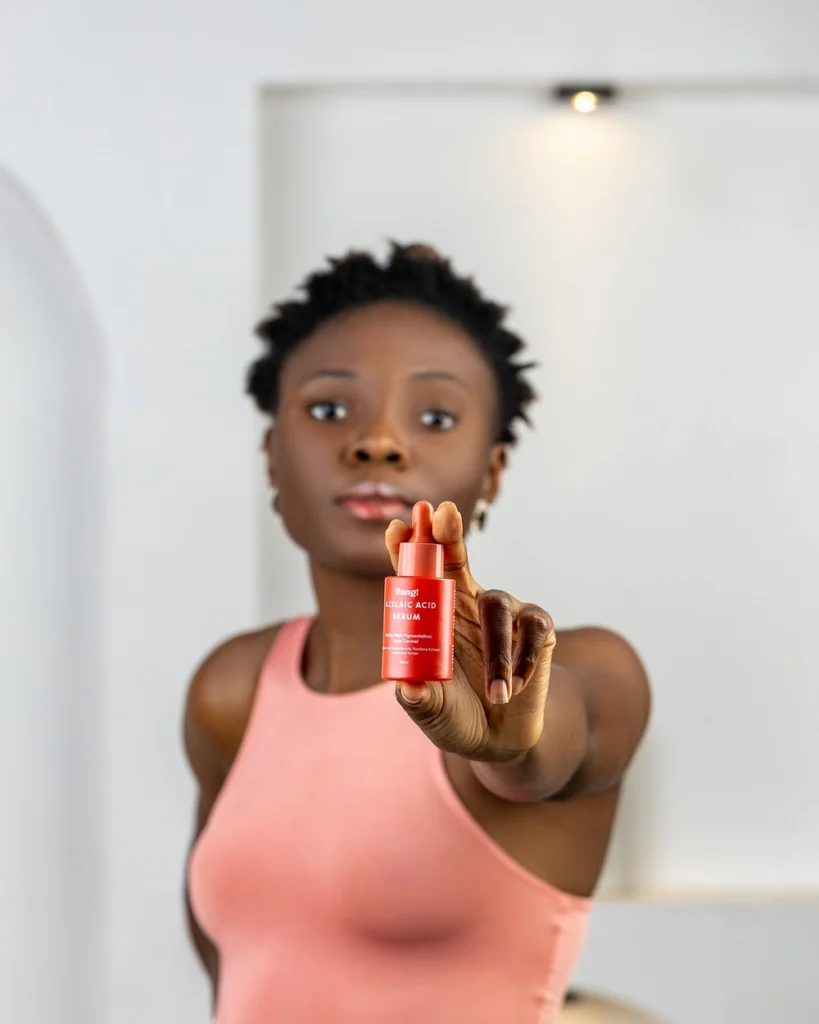
Free Shipping on Orders Over N200,0000 within Lagos
Buy 300k and get 20% off any spa service
Free Shipping For Orders over $150
Free Shipping For Orders over £100

Azelaic acid vs glycolic acid, which should you use to treat hyperpigmentation?
So you’re starting to see dark spots on your skin. Maybe it’s from that hormonal breakout a few months ago, or sun exposure that didn’t spare your melanin-rich skin.
Either way, you’ve done your research and discovered that both azelaic acid and glycolic acid work for hyperpigmentation. Now you’re at a crossroads, not knowing which one to opt for.
We got you? Grab a cup of tea and get comfy, because we’re breaking down these two powerful acids, how they work, what makes these skincare products different from each other, and how to know which one your skin needs. Take it from a brand, that consistently provides targeted and effective solutions for people of color.
Both azelaic acid and glycolic acid work for hyperpigmentation. However, they target hyperpigmentation differently.
Azelaic acid regulates melanin production in pigmented areas while glycolic acid gently exfoliates/sheds off dead skin cells to reveal a brighter skin tone. More so, azelaic acid is best for sensitive skin, acne marks, melasma, and deep pigment issues.
Glycolic acid is great for exfoliating dull skin and mild surface discolouration.
Overall, whichever you choose to use, start slow. Be consistent and always wear sunscreen because using acids increases your sensitivity to UV radiation.
Azelaic acid is a dicarboxylic acid that’s naturally found in grains like barley and wheat. Here’s what makes azelaic acid great for hyperpigmentation, especially for melanin-rich skin:
Did you know dermatologists often prescribe azelaic acid to treat melasma, a notoriously stubborn pigmentation concern that affects many people of colour?
In simple terms, azelaic acid is one of the best acids for treating hyperpigmentation, like dark spots, especially in melanin-rich skin.
Not to worry, soon you’ll discover how to use azelaic acid for hyperpigmentation. But first, let’s get some insight into what glycolic acid is and what it does.
Glycolic acid is an exfoliant (alpha hydroxy acids (AHAs). Glycolic acid gently exfoliates/sheds off dead skin cells to reveal a brighter skin tone
Here’s how it works for hyperpigmentation
Amazing benefits, right?
But it can be a bit harsh for those with sensitive or reactive skin. Plus, for deeper hyperpigmentation (like hormonal melasma or post-acne marks in darker skin tones), glycolic acid may not go deep enough on its own.
Well, here’s what you need to know;
Go with azelaic acid. It works at the source of excess melanin, not just the top layer. Plus, it’s gentle, even if your skin is reactive or sensitive.
In a nutshell, if you’ve been scared of trying acids because your skin reacts easily, azelaic acid is your safe zone.
Glycolic acid might be your best bet. However, use with caution, especially if you’re new to using skincare actives (acids).
Yes, it’s possible to use both azelaic acid and glycolic acid together. But this can be tricky.
As skincare experts, we’ve seen cases where combining acids leads to irritation and a damaged skin barrier.
So, we do not recommend using both azelaic acid and glycolic acid in the same routine. Instead, use them on alternate days.
For instance, use azelaic acid 2-3 times a week, at night only. (say Monday, Wednesday, and Friday)
Then use glycolic acid on alternate days. Nighttime too. (say Tuesday and Saturdays)
But if your skin is new to acids or you’re prone to irritation? We highly recommend you stick to just one, and guess which we recommend? Dang! Azelaic Acid Serum
If you’ve made it this far, chances are you’re leaning towards azelaic acid, and we love that for you.
Our Dang! Azelaic Acid Serum isn’t just effective. It’s intentional skincare for people of colour, created with the unique needs of melanin skin in mind.
Want clear and glowing skin that doesn’t require filters and heavy makeup? Try the Dang! Azelaic Acid Serum here
Hyperpigmentation can be tricky, especially for dark skin. However, choosing the right skincare uniquely crafted for dark skin makes all the difference.
In a nutshell, when it comes to treating hyperpigmentation in darker skin tones, azelaic acid remains the safest and most effective treatment, according to this clinical study.
More so, as you continue to grow in your skincare journey, you’ll begin to realise there are several skincare products for hyperpigmentation for black skin.
The trick is to listen to your skin and focus on what works for your skin.
In some cases, we’ve seen that combining certain acids brings about enhanced benefits, allowing you to target multiple skincare concerns simultaneously.
For instance, there’s a way to combine azelaic acid, niacinamide, and tretinoin to achieve faster and more balanced results. But remember, consistency is key, and so is guidance.
Always consult with a skincare expert before mixing actives, especially when dealing with melanin-rich skin that requires extra care.
Your skin deserves patience, the right products, and a routine tailored to you. Trust the process, stay informed, and most importantly, be kind to your skin.
Despite being a very gentle acid, we do not recommend using it daily, especially for first-timers.
This is because individual reactions to this acid may vary. So we recommend using it 2-3 times weekly to see how your skin reacts.
If you’re just starting. Then you can increase frequency as your skin becomes more acquainted with the acid.
Yes, you shouldn’t use azelaic acid with acids like benzoyl peroxide, as this combo can be extremely drying.
It’s possible to experience mild purging when using azelaic acid. This may come in the form of an increase in breakouts, which usually subsides within 2- 4 weeks. You may also experience mild stinging.
Ultimately, it’s not common for azelaic acid to cause skin purging because it is a mild acid. However, if signs of irritation continue, stop using it and consult a skincare expert.
Both are effective for hyperpigmentation, but they work in different ways:
If your primary concern is stubborn pigmentation or melasma, azelaic acid is often better tolerated and more effective for long-term use. For extra brightening, many skincare experts recommend layering both (Vitamin C in the morning, Azelaic Acid at night), as long as your skin can handle it.
10% (found in most over-the-counter products) is effective for mild to moderate hyperpigmentation and is generally safe for daily use.
On the other hand, 15% to 20% (available by prescription) is more potent and clinically proven to treat conditions like melasma and post-inflammatory hyperpigmentation more aggressively.




